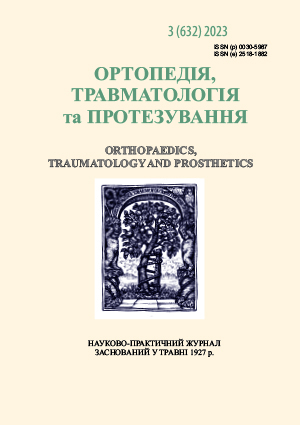TREATMENT OF NEGLECTED COMPLEX DISLOCATIONS IN THE ELBOW JOINT (CLINICAL CASE)
DOI:
https://doi.org/10.15674/0030-59872023357-61Keywords:
Elbow joint, neglected complex dislocationsAbstract
Neglected complex dislocations of the elbow joint are not often pathology, bat its treatment is serious problem and demand an individual tactic of treatment. Objective. To present a clinical case of consecutive treatment the neglected complex dislocations of the elbow. Methods. The clinical case of neglected complex dislocations to the back with coronoid process fracture II type (by Regan, Morrey) with displacement to a 60-year old man, who could not get medical care within 6 months. At the moment of examination patient had formed steadfast interrelations of displaced elbow joint structures with loosing of limb functionality. At the first stage, the forearm was distracted by using an external fixation device end redaction in the shoulder-elbow joint was achieved. At another stage arthrolysis, open redaction of the radial head, restoration of the lateral ligamentous apparatus was complected. In three weeks restoration of movements in the elbow joint has begun, ensuring movements close to the natural axis of the forearm rotation, which was provided by the external fixation device. Results. In 6 months the patient noted moderate pain only after intense physical load, hi doesn’t take painkillers, volume o f rotational m ovements: 2 0/0/25 (45°), e xtension-flexion movements: 0/15/118 (103°). The patient actively uses the limb for self-care and in work activities. According to the Mayo Elbow Performance Score the sum of points is 75, this means — the result is good. Conclusions. In cases of neglected complex dislocations for significant periods of existence (more than 3–4 months) staged treatment tactics is appropriate with using external fixation devices, by perforce perform open and closed manipulations, which depends on the specific clinical situation.
References
- Crenshaw, A. H. (2021). Old unreduced dislocations. In F. M. Azar, Beaty J. H. (Ed.), Campbell's Operative Orthopaedics (рр. 3246–3270). Elsevier Inc.
- Donohue, K. W., & Mehlhoff, T. L. (2016). Chronic Elbow Dislocation. Journal of the American Academy of Orthopaedic Surgeons, 24 (7), 413–423. https://doi.org/10.5435/jaaos-d-14-00460
- Mader, K., Ivo, R., Dargel, J., & Pennig, D. (2009). Treatment of chronically unreduced complex dislocations of the elbow. Strategies in Trauma and Limb Reconstruction, 4 (2), 49–55. https://doi.org/10.1007/s11751-009-0064-1
- Jupiter, J. B., & Ring, D. (2002). Treatment of unreduced elbow dislocations with hinged external fixation. The Journal of Bone and Joint Surgery-American Volume, 84 (9), 1630–1635. https://doi.org/10.2106/00004623-200209000-00017.
- Linscheid, R. L. & Wheeler, D. K. (1965). Elbow Dislocations. JAMA: The Journal of the American Medical Association, 194 (11), 1171. https://doi.org/10.1001/jama.1965.03090240005001
- Lo, C. Y., & Chang, Y. P. (2004). Neglected elbow dislocation in a young man: treatment by open reduction and elbow fixator. Journal of Shoulder and Elbow Surgery, 13 (1), 101–104. https://doi.org/10.1016/s1058-2746(03)00089-2
- Мehta, S., Sud, A., Tiwari, A., & Kapoor, S. (2007). Open Reduction for Late-Presenting Posterior Dislocation of the Elbow. Journal of Orthopaedic Surgery, 15 (1), 15–21. https://doi.org/10.1177/230949900701500105
- Morrey, B. F. (1993). Functional evaluation of the elbow. In B. F. Morrey, K.-N. An, E. Y. Chao (Еd.), The elbow and its disorders (рр. 86–89). Philadelphia: W. B. Saunders Company.
- Regan, W., & Morrey, B. (1989). Fractures of the coronoid process of the ulna. The Journal of Bone & Joint Surgery, 71 (9), 1348–1354. https://doi.org/10.2106/00004623-198971090-00011
- Pal, C. P., Mittal, V., Dinkar, K. S., Kapoor, R., & Gupta, M. (2021). Neglected posterior dislocation of elbow: A review. Journal of Clinical Orthopaedics and Trauma, 18, 100–104. https://doi.org/10.1016/j.jcot.2021.04.016
- Pennig, D., Gausepohl, T., & Mader, K. (2000). Transarticular fixation with the capacity for motion in fracture dislocations of the elbow. Injury, 31, 35–44. https://doi.org/10.1016/s0020-1383(99)00261-2
Downloads
How to Cite
Issue
Section
License

This work is licensed under a Creative Commons Attribution 4.0 International License.
The authors retain the right of authorship of their manuscript and pass the journal the right of the first publication of this article, which automatically become available from the date of publication under the terms of Creative Commons Attribution License, which allows others to freely distribute the published manuscript with mandatory linking to authors of the original research and the first publication of this one in this journal.
Authors have the right to enter into a separate supplemental agreement on the additional non-exclusive distribution of manuscript in the form in which it was published by the journal (i.e. to put work in electronic storage of an institution or publish as a part of the book) while maintaining the reference to the first publication of the manuscript in this journal.
The editorial policy of the journal allows authors and encourages manuscript accommodation online (i.e. in storage of an institution or on the personal websites) as before submission of the manuscript to the editorial office, and during its editorial processing because it contributes to productive scientific discussion and positively affects the efficiency and dynamics of the published manuscript citation (see The Effect of Open Access).














